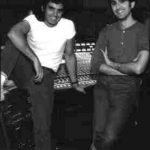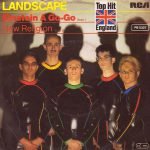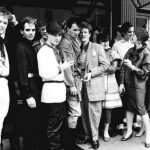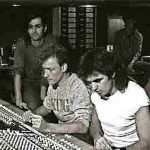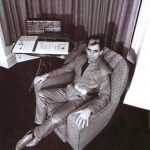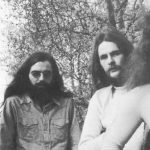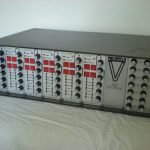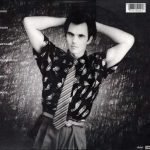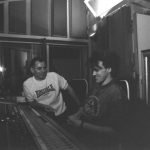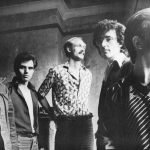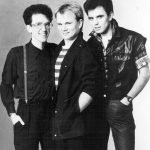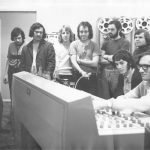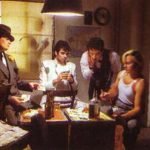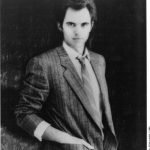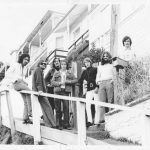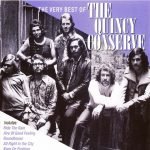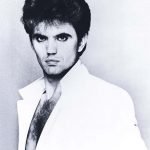+ By Leigh Glenn + Photos courtesy of Burgess World Co.
Richard James Burgess could not have received a better present for his third birthday. That day in 1952 coincided with a festival in Kettering, Northamptonshire, England, and the family stood listening to the British brass bands representing the area’s shoemakers and clothiers. The sound waves flowed from the arms and hands of the drummers, the lungs and lips of the tubaists and bass trombonist, and pulsed through the earth into his feet, up his legs, into his heart. So powerful were the drum lines, he says, “I can relive it in a second.”
 For Mayo resident Burgess, a Canopus in the constellation of latter-day music, sound—drums especially—is everything. Today, at 67, not one area of his life is untouched by music: playing, composing, inventing, programming, managing and producing bands, studying music and music history, and writing about its production.
For Mayo resident Burgess, a Canopus in the constellation of latter-day music, sound—drums especially—is everything. Today, at 67, not one area of his life is untouched by music: playing, composing, inventing, programming, managing and producing bands, studying music and music history, and writing about its production.
In Kettering, three generations lived at his grandparents’ house, where the radio was always on. At seven, Burgess tried to play Lonnie Donegan’s versions of “Rock Island Line” and “Midnight Special” on ukulele. Three years later, his parents sought better opportunities in Christchurch, New Zealand. There, he wanted to play honky-tonk piano. His parents wanted him to focus on schoolwork. So he bought drum brushes, practiced on every flat surface, and drove his parents nuts.
At 14, he opted for a drum kit over a car. His father schlepped him to plentiful gigs at bars and pubs. He soon made enough to buy wheels. “People paid for music,” Burgess says. “There was no idea that music was free.”
Christchurch and New Zealand were blessed with great drummers, including Bruno Lawrence, whom Burgess replaced in the Quincy Conserve. His parents were very proud when he joined that band. “I was making very good money,” he says, “and that was really their only concern—that I would be able to make a good living at it.”
 Recording and electrifying the drums also piqued his interest, and he began to experiment. In the early 1970s, he left New Zealand to study at Berklee College of Music in Boston, Massachusetts, then at Guildhall School of Music and Drama in London. He later earned a Ph.D. in ethnomusicology from the former University of Glamorgan.
Recording and electrifying the drums also piqued his interest, and he began to experiment. In the early 1970s, he left New Zealand to study at Berklee College of Music in Boston, Massachusetts, then at Guildhall School of Music and Drama in London. He later earned a Ph.D. in ethnomusicology from the former University of Glamorgan.
“They slammed the door shut on the swinging ’60s the week before I got to London,” Burgess says. He would have been part of that scene, but his other-continent sensibilities lent something different to the era then unfolding. He’d grown weary of Fender Stratocaster/Fender Rhodes/Fender bass/acoustic drums combos. The development of electronic music—through Moog in the United States, EMS in the United Kingdom, and Roland in Japan—expanded possibilities for composition.
Despite criticism about electronics destroying music, Burgess offers a different take: even those only so-so on certain instruments could do everything. “Maybe your fingers wouldn’t do it or your feet or hands wouldn’t, but if you could conceive it, you could perform it using a computer.”
Burgess and some kindred early adopters formed the band Landscape in 1974, and used electronics to explore rock, jazz, and sound itself. Before Christmas 1979, Burgess and fellow Landscape keyboardist and woodwinds player John Walters visited Roland’s London warehouse. Because of the staff holiday party, they had to be locked in. They spent more than seven hours playing with the MC-8 MicroComposer and left inspired, knowing that was the way records were going to be made. Burgess invested £5,000 in an MC-8, and with it, the band made its second album, From the Tea-rooms of Mars . . . to the Hell-holes of Uranus.
 Right after Tea-rooms, Burgess produced Spandau Ballet’s Journeys to Glory. In November 1980, that band’s “To Cut a Long Story Short” landed in the fifth spot on the UK Singles Chart. Landscape rocketed to the same spot in February 1981, with “Einstein A Go-Go,” and “Norman Bates” made it to number 40 by May. Burgess had served as drummer on The Buggles The Age of Plastic, which included “Video Killed the Radio Star.” The song hit number one in September 1979, and by August 1981, it heralded a second British music “invasion” with MTV—and, no doubt, much parental gnashing of teeth when teens ruled the remote while waiting . . . and waiting . . . for their favorite videos.
Right after Tea-rooms, Burgess produced Spandau Ballet’s Journeys to Glory. In November 1980, that band’s “To Cut a Long Story Short” landed in the fifth spot on the UK Singles Chart. Landscape rocketed to the same spot in February 1981, with “Einstein A Go-Go,” and “Norman Bates” made it to number 40 by May. Burgess had served as drummer on The Buggles The Age of Plastic, which included “Video Killed the Radio Star.” The song hit number one in September 1979, and by August 1981, it heralded a second British music “invasion” with MTV—and, no doubt, much parental gnashing of teeth when teens ruled the remote while waiting . . . and waiting . . . for their favorite videos.
Out of that invasion came many bands—infused with glam and synthpop—that formed what Burgess dubbed the New Romantic movement. Think Culture Club and Duran Duran, among others.
Burgess as producer let many bands get away, from Edie Brickell and New Bohemians to the Human League. But, in the 1980s, he usually had ten projects from which to choose. “All good,” he says.
One band that could have slipped by was Jimmie’s Chicken Shack. In August 1994, Burgess was visiting the Annapolis area with his family and threw out his back. A pizzeria frequented by skateboarders was near the chiropractor’s office in Arnold, and Burgess’ then-wife stayed outside to chat with them. Dietram von Schilcher, one of the skateboarders, was a roadie for Jimmie’s Chicken Shack. When Burgess emerged from the office, he was directed to The Mansion on Generals Highway, a ramshackle building that used to be near present-day Rams Head Roadhouse, where local and regional bands played and recorded. While there, Burgess didn’t get to meet the band’s frontman, Jimi Davies (this magazine’s publisher), but he took a stack of cassettes, including Chicken Scratch, which intrigued him. The next year, he met with Davies and told him he could get him a deal. “They thought I was a crazy guy,” he says.
In August 1995, Burgess played the cassette for a friend at Mercury Records who wanted to know when he could see the band. Given the industry’s usual pace, it wasn’t until July 1996 when Burgess finally signed Jimmie’s Chicken Shack with Elton John’s Rocket Records. He still works with Davies.
In 2001, Burgess embraced the opportunity to lead licensing, marketing, and sales for Smithsonian Folkways, a nonprofit recording label of the Smithsonian Institution that is meant to keep titles in print however small the demand. Burgess wanted to preserve the origins of music that he liked, including Lead Belly, whose music he had—unknowingly, via Donegan—listened to as a child.
 His experiences and strong ethic about the value of music made him the person to lead the American Association of Independent Music, or A2IM, of which, after three years on the board, he became CEO in January 2016. As A2IM chief, Burgess wants to ensure that creators and copyright owners control their copyrights and are equitably compensated. With digital distribution, artists—the industry’s keystone species—are being decimated by technology companies that view creative works as “content,” says Burgess. So despite the vast fortunes generated by the music, he says, “only a tiny fraction of that value is finding its way back to artists, writers, musicians, labels, and publishers.” YouTube, for example, usurps copyright control, so musicians are either not paid or badly underpaid for their work, says Burgess.
His experiences and strong ethic about the value of music made him the person to lead the American Association of Independent Music, or A2IM, of which, after three years on the board, he became CEO in January 2016. As A2IM chief, Burgess wants to ensure that creators and copyright owners control their copyrights and are equitably compensated. With digital distribution, artists—the industry’s keystone species—are being decimated by technology companies that view creative works as “content,” says Burgess. So despite the vast fortunes generated by the music, he says, “only a tiny fraction of that value is finding its way back to artists, writers, musicians, labels, and publishers.” YouTube, for example, usurps copyright control, so musicians are either not paid or badly underpaid for their work, says Burgess.
Burgess was there when the now-antiquated Digital Millennium Copyright Act was passed in 1998. Under section 512 of the law, someone who inadvertently violates copyright by posting something can take it down without being sued. But this safe-harbor provision is abused daily, whack-a-mole fashion, he says: Get a section-512 request, remove the song, and a few seconds later, it’s back up under a different URL.
“If we value music, we need to value those who create it. Musicians have to eat and pay bills like everyone else,” says Burgess, who spends $10/month for a streaming subscription. “Imagine if you could drive a free Mercedes by listening to ads all day. Because you can do that with music, it’s not surprising that people do. [But] music should not be free unless the creator wants it to be.”
 Burgess still plays drums every chance he gets. He draws inspiration from a range of drummers, including Ginger Baker, Billy Cobham, Elvin Jones, and Tony Williams. He admires studio drummers for their precision, along with Ringo Starr, who, he says, “plays songs in a musical way that many drummers don’t,” and from whom he feels he’s benefited by studying.
Burgess still plays drums every chance he gets. He draws inspiration from a range of drummers, including Ginger Baker, Billy Cobham, Elvin Jones, and Tony Williams. He admires studio drummers for their precision, along with Ringo Starr, who, he says, “plays songs in a musical way that many drummers don’t,” and from whom he feels he’s benefited by studying.
Despite having many works in various stages of readiness, Burgess’ priority is to ensure that the next generations of creators can make a decent and equitable living from music. “I was able to make a living from music—the deals were far from fair, but I did okay.” And he’s always been into finishing things, even if they are difficult. “I struggle with it like everyone, but it would be completely unsatisfying to have a bunch of unfinished stuff.” █



